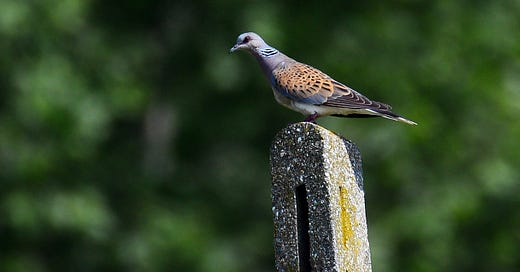The various oohs and coos of our collared doves, woodpigeons and feral pigeons tend to divide opinion. Not so the song of the turtle dove.
Usually described as a ‘purr’, the turtle dove’s one-trick song has a warmth that reflects the season in which we might hear it - only when the spring is at its lushest or has given way to summer.
That throaty sound, heard well, is unlikely to be mistaken for another bird, and might not be taken for a bird at all. This is compounded by their habit of singing out of sight, often hidden among dense foliage.
When I was growing up in Kent in the 1980s, this was a sound I could hear in gardens and wooded spots all around our village. It was years before I put the sound together with the sight of the bird that makes it.
The ‘turtle’ in the name refers to that sound rather than to any relationship with reptiles - ‘turtur’ is one way of describing their song, and the word that makes up part of their Latin name.
In times past the turtle dove’s discreet behaviour was counterbalanced by their abundance. Across many parts of rural England, turtle doves would have been easy to see, shuffling around at the field edge or perched up on exposed branches.
They are the most richly coloured of our doves, a sumptuous mix of bruised pinks, caramels, charcoal black, slate and pearly greys, with bright white underneath and at the edges of the tail.
The decline in their fortunes has been among the most dramatic of our birds in recent decades. Only around 1 in 10 of the turtle doves present in the mid-1990s can be found today. Just a few thousand birds return to us each summer.
Turtle doves seem to be under pressure on every front. In Britain many of their former haunts have been tidied into a state that gives them neither the cover they need for nesting, nor the weedy, seedy margins they want to feed in.
Their wintering grounds in West Africa are being degraded by development and climate change, and in between they are frequently shot as they migrate through southern Europe.
The remnant population is now mainly found in the South East of England and East Anglia, in untidy corners, river valleys and scrubby woodland. Although now sparsely spread, they are a bird you might stumble across, on a warm, still day in June.
You may struggle to see it, but there are worse ways to spend your time.
Next week: Spotted Flycatcher
Credits:
Image by francescobovolin on Pixabay.





Are we listening to the Turtle Dove getting shot at? It is so blissful...and then the shots....